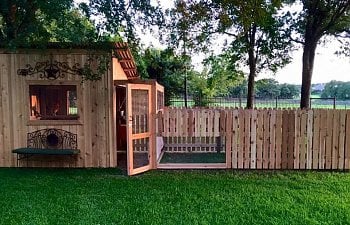So, you fell for the temptation of new chicks in the feed store this spring and got your new charges safely set up in a brooder. They are going to outgrow that brooder within 6-7 weeks and will need to move outside to a coop. Now you have two options: you can either go out and buy a coop, or you can build one yourself. With the former, besides it being a sometimes pricey endeavor, you will have to "take what you get" and have little say in the design, details, etc. With the latter, you can make sure it’s exactly what you need to fit your budget, your chickens, and your circumstances. But it isn’t as simple as throwing together a structure and putting a few hens in it… There are a few VERY important things to consider when building your own coop.
Permits And Local Chicken Laws and Ordinances
Find out if you CAN build a coop on your property and it goes without saying if you are allowed to keep poultry and how many. In most cases, a small coop will be allowed without the need for anything particular or permission, but bigger coops may require a permit before you can legally build it. This will require getting a building permit, involving showing your coop plans, and then requesting allowance. In most cases, you won’t have a problem, but be sure to check it out just in case. Also, check out your local laws and restrictions regarding the location of the coop. Many towns, cities, and municipalities have very specific codes in place regarding placement of coop, for example, no closer than 20 feet from your property's boundary, or no closer than 40 feet from your nearest neighbor's house. Find out before you build!https://www.backyardchickens.com/atype/3/Laws
Location of the Coop
Once you’ve confirmed that you are allowed to build and what (if any) the restrictions are, you'll need to select the best location for the coop. Convenience is a factor, but things like noise and smell should be taken into consideration. Having the coop close to your house is going to be great until your insomniac rooster starts crowing at 03:00 am! Yep, I had a few of those and they don't crow once or twice, they crow until they are sure you and the entire household is awake and craving fried chicken. With that taken into consideration, pick a spot that would be one that allows the chickens to get the benefit of the morning sun without the afternoon heat as much, sheltered from excessive wind and weather conditions, with some shade from trees, if possible and not too close to your, or the neighbors' house to be a nuisance.How Big Should I Make the Coop and Run?
That depends on how much space you have available and how many chickens you plan on housing in the coop. Would your flock have free range time during the day, or would they be "cooped up" permanently? Would they have access to the outdoors/run during winter when the snow is 3 feet deep? If the former you can get away with a smaller coop, but more is always better. If the latter build the coop as large as possible and keep the number of inhabitants down (easier said than done, I know). Member Ridgerunner wrote an excellent article on the topic of coop space, here:https://www.backyardchickens.com/a/how-much-room-do-chickens-need
Building Materials
The sky is the limit when it comes to building materials for coops. I've seen coops build from a wide range of materials ranging from old windows to gutted cars! Wood seems to be the #1 building material with pallets a very popular source, especially for the frugal-minded or those on a budget. Here are some ideas, examples and discussions on the topic:https://www.backyardchickens.com/a/hespo-clucky-inn-pallet-coop
https://www.backyardchickens.com/a/hinkel-haus-made-of-pallets-recycled-wood-pickets
https://www.backyardchickens.com/t/...-money-and-build-with-recycled-materials/0_30
Regardless of what materials you use, make sure it's sturdy enough to protect your flock from adverse weather conditions and predators! For more detailed predator protection tips, have a look here:
https://www.backyardchickens.com/a/chicken-predators-pests-how-to-protect-treat-your-flock
Ventilation
Another VERY important aspect to consider is proper ventilation in the coop. Again, more is better, especially during the winter months when can make all the difference between a sick flock and a healthy one. You need to make sure that there is proper airflow within the coop, without making it drafty. Here is another excellent article on the topic with some suggestions to include in your design:https://www.backyardchickens.com/a/...-go-out-there-and-cut-more-holes-in-your-coop
Adding Electricity
Electricity in the coop can be handy for extra lighting during the short winter days and for additional heating when needed. Faulty electricity installations can pose a huge fire risk though, so if you choose to install an electrical outlet in the coop, have a licensed electrician come down and take a look at your plans and your finished work. Fire prevention and electricity safety tips are discussed here:https://www.backyardchickens.com/t/745178/fire-safety-in-your-chicken-coop-barn-important/0_30
Further and Recommended Reading
Coop Plans and Designs: https://www.backyardchickens.com/articles/category/chicken-coops.12/Winter chicken keeping: https://www.backyardchickens.com/a/winter-chicken-keeping
Heating the coop: https://www.backyardchickens.com/a/...led-look-at-the-question-of-supplemental-heat
Nest Boxes: https://www.backyardchickens.com/a/pictures-of-chicken-nesting-boxes-how-to-build-a-nest-box

